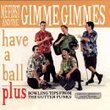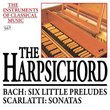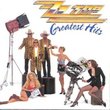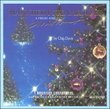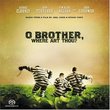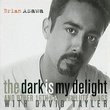| All Artists: Lynn Harting-Ware Title: Angelica Members Wishing: 1 Total Copies: 0 Label: Acoma Original Release Date: 9/7/1997 Release Date: 9/7/1997 Album Type: Single Genres: Dance & Electronic, Classical Styles: Chamber Music, Historical Periods, Baroque (c.1600-1750), Classical (c.1770-1830), Instruments, Strings Number of Discs: 1 SwapaCD Credits: 1 UPC: 640139573527 |
Search - Lynn Harting-Ware :: Angelica
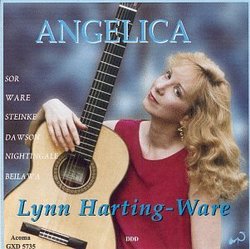 | Lynn Harting-Ware Angelica Genres: Dance & Electronic, Classical
ANGELICA In search of a common thread for this program, my strongest sense of unification is that many of the twentieth-century pieces evolve from spiritual inspirations with the goal of transcending earthly confines. Aft... more » |
Larger Image |
CD Details
Synopsis
Album Description
ANGELICA In search of a common thread for this program, my strongest sense of unification is that many of the twentieth-century pieces evolve from spiritual inspirations with the goal of transcending earthly confines. After solidifying my musical interpretations, I believe that four of the pieces contain messages beyond the notes, rhythms and melodies that comprise music. The spiritual aspects of these pieces made me feel as a type of "messenger" engaged in a non-verbal realm of communication. The music and pure sound, unencumbered by the burden of thought, are the vehicles through which one passes or connects to the metaphysical world. Angelica is derived from the Greek word "aggelos" which means messenger. Universally, angels are distinguished as mediators and messengers between the human and the divine. My hope is that these pieces will reveal their message of transcendence to every open mind willing to make the journey through sound. Peter Ware's Elegy opens poetically as a mournful remembrance for a departed soul. Beginning with slow chords, it proceeds into a triple meter Andante. The melodic line imparts a sacred quality similar to Gregorian chant. Accompanying notes and chords are heard in counterpoint, in quiet response to the melody. The Totentanz is a dance of death, representing bodily muscle spasms at the moment of death. Fifteenth and sixteenth-century artists such as Holbein and D|rer depicted death as a gruesome fiddler, with medieval dancers costumed as skeletons. The Totentanz has a perky character, not without an element of jest. It opens with a four-note motive (or single affection) which is spun out in a Baroque fashion to pervade the entire musical fabric. Use of motoric rhythm sustains a sense of momentum, until the ending where it winds down majestically. Three for Guitar by Bruce Bielawa, is a dreamscape of sound in which fragments of music emerge as images in a dream. In a dream, disparate elements are juxtaposed, consisting of part memory and part subconscious fears or desires with frequent shifts of location and scenery. Images are seen and heard, and perceived with meanings felt through emotion rather than reason. An introduction opens the first movement and leads to a wave-like figuration. A delicate triplet section follows. The opening motive returns, but leads this time to an aggressive passage which comes to rest in a tranquil closing. The second movement opens in a declamatory, recitative style. An aria passage opens with an arpeggio figure which sets the mood for a beautiful, long-breathed melody. The declamatory material returns and ends with an allusion to the arpeggio figure. The third movement takes form as a dissonant dialogue between high and low notes on the guitar. Syncopations characterize a section marked "funk," a nightmarish revelry in rhythmic aggression. Towards the end, the emotional spectrum shifts to include the lyrical, grandiose and melancholy. Daniel Nightingale's a la luz de la luna llena translates as "in the light of the full moon". It is the musical description of a walk along the shores of the Delaware River on a moonlit night. Evocative tonal imagery creates a magic that transcends that time and place. Composed in a contemporary Spanish idiom, a slow introduction proceeds "darkly" in an improvisatory style. High and low registers of the guitar are explored, while snap pizzicati add a dramatic effect. A fantasia-like form follows, recapturing the mystery and wonder. Another New Beginning II by Greg Steinke, draws inspiration from a poem by K'os Naahaabii in which the poet having survived a night of misery is able to rise above in the freshness of morning air and soar with the nighthawk. The composer also draws upon the horrific events in the lives of the Jews as depicted in Schindler's List. Evoking images of the first stanza of the poem, the first section is comprised of timbral gestures, each one set apart as an independent thought, but having grown out of the previous. A second lyrical section captures images of the third stanza's transcendence. Next heard is an evocation of gun shots and people scurrying, portrayed musically through novel effects on the guitar. The lyrical section returns in a triumphantly soaring conclusion. Added to this program of evocative pieces are three pieces, including Ferdinando Sor's Variations on a Theme by Mozart. A dramatic introduction precedes the statement of Mozart's theme. The theme itself, taken from The Magic Flute, bespeaks the beauty of Mozart in its natural simplicity and symmetry. Complemented by Sor's flare and idiomatic writing for the guitar, these variations sparkle, standing as a favorite in the repertoire. Doug Dawson's Baltimore Sonata is a contemporary work which combines traditional classical language and form with jazz harmonies and melodies. The first and third movements are lively with an unfaltering rhythmic energy. Interspersed into this highly original marriage of genres are some common jazz riffs, heard most abundantly in the slower second movement. The effect is a wonderful tongue-in-check nod to jazz, and the relaxed feel of swing. Pavanas and Canarios are popular pieces by Spanish composer Gaspar Sanz that need little in the way of description. The slower Pavanas sets up a contrast to the lively dance of Canarios. - Lynn Harting-Ware
Similarly Requested CDs
| Zz Top Greatest Hits Genres: Pop, Rock, Classic Rock, Metal Label: Warner Bros. | |
| Various Artists 20 Best of 60's Rock N Roll (Dig) Genres: Pop, R&B, Rock Label: Madacy Records | |
| The Steve Miller Band Greatest Hits 1974-78 Genres: Pop, Rock, Classic Rock, Metal Label: Capitol | |

 Track Listings (13) - Disc #1
Track Listings (13) - Disc #1